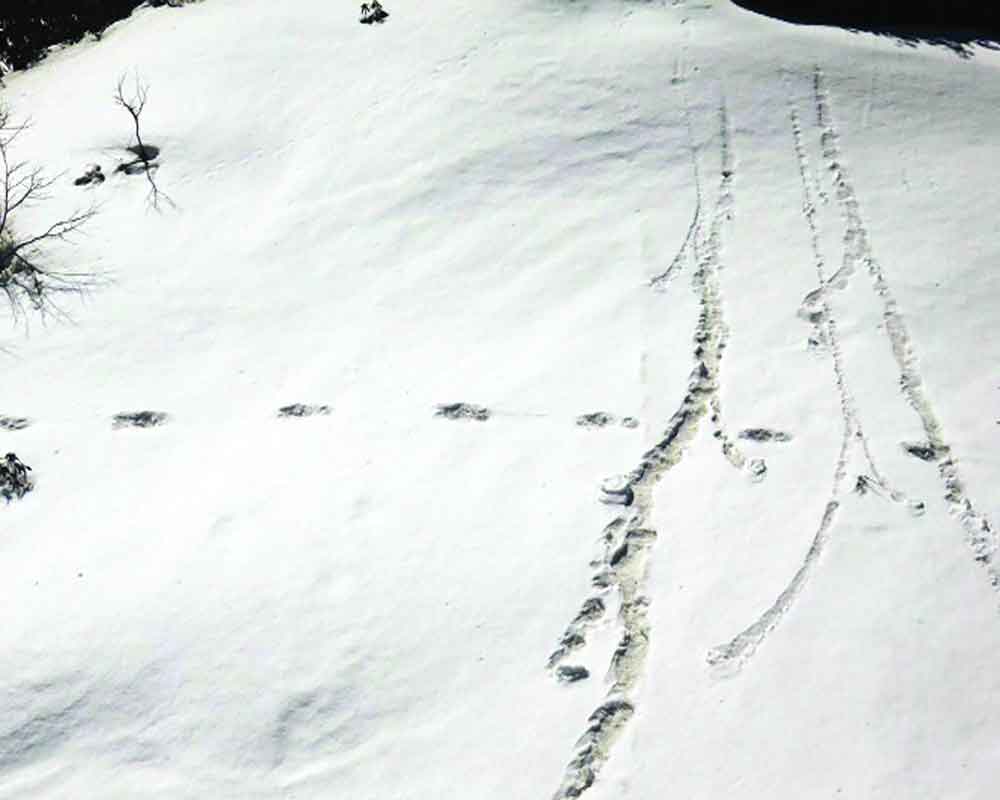32x15 inch footprints spotted in Nepal by Indian Army expedition team
In the first ever discovery of its kind, the Indian Army on Tuesday said its mountaineering team in Nepal sighted the footprints of mythical beast Yeti whose pugmark measured about 32X15 inch.
The Army tweeted photographs of Yeti’s pugmarks and said the evidence will be shared with the experts once the expedition team returns by month end or early June.
“It was spotted close to Makalu Base Camp on April 19, 2019 in Nepal, it tweeted, adding that the “elusive snowman” has also only been sighted nearby at Makalu-Barun National Park and in the images, the prints appear to be of a single foot.
Commonly known as the “abominable snowman,” scientists and experts world over have unsuccessfully tried to sight the mythical animal for the last several decades. In this backdrop, the latest finding by the Army team is bound to generate a great deal of interest. The footprints were measured by callipers and Army sources claimed that those matched with earlier theories, adding the photographs were released to “excite scientific temper.” The evidence will help in reaching logical conclusion, they said.
Incidentally, this is also the first time that an Indian Army expedition is trying to scale Mt Makalu in Nepal. The spot where the footprints were sighted is about 180 km east of Kathmandu, 90km west of Kanchenjunga and 40 km south east of Everest. Moreover, the footprints were found at a height of nearly 15,000 feet and it is believed the Yeti generally inhabits at high altitude in the Himalayan ranges.
The 18-member team led by Major Manoj Joshi started the expedition on April 2.
Makalu is the fifth highest mountain in the world at 8,485 metres. It is located in the Mahalangur Himalayas on the border between Nepal and Tibet, China. Army sources said its report about sighting is based on “physical proof of on-the-spot narration”, photos and videos. “We got the inputs about 10 days back and yet we held on to it,” they said, promising that the “photos and videos may surprise you.”
“We tweeted as we thought prudent to excite scientific temper and rekindle the interest. Some of us who reject the story surely shall have a definite answer to the evidences. As they say nature, history and science never write their final story,” said a source. He also said the photographs were transmitted through satellite phone and video footage was likely to be available after the team gains more height and get clear atmospheric conditions for communicating.
There have been many stories about the mystery of the “the abominable snowman”, mostly based on unconfirmed, often fantastical accounts of its giant size and terrifying howl. Though scientists are yet to acknowledge the existence of such a beast or creature, the Yeti is part of folklore in South Asian region.
Some reports in the past have declined to give credence to the existence of the Yeti and said the creature sighted by may have been different kinds of bear including the Asian black bear, the Tibetan brown and the Himalayan brown bear.
In Nepali folklore, Yeti is a mythical ape-like creature taller than an average human that is said to inhabit the Himalayas, Siberia, Central and East Asia. Stories of the Yeti first emerged as a facet of Western popular culture in the 19th century.
Given the lack of evidence of its existence, the scientific community has generally regarded the Yeti as a legend. In one genetic study, researchers matched DNA from hair samples found in the Himalaya with a prehistoric bear from the Pleistocene epoch.
Though the hunt for the mythical beast stretches back centuries, tales of a wild hairy beast roaming the Himalayas captured the imagination of climbers in Nepal in the 1920s, prompting many, including Sir Edmund Hillary. Sightings have been reported for centuries. Footprints have been spotted and stories have been passed down from generation to generation.
A 2017 DNA study of purported Yeti samples from museums and private collections provided insight into the origins of this Himalayan legend. The research, published in the journal Proceedings of the Royal Society B, analysed nine Yeti specimens, including bone, tooth, skin, hair and faecal samples collected in the Himalayas and Tibetan Plateau.
Of those, one turned out to be from a dog. The other eight were from Asian bears -- one from an Asian black bear, one from a Himalayan brown bear, and the other six from Tibetan brown bears. “Our findings strongly suggest that the biological underpinnings of the Yeti legend can be found in local bears, and our study demonstrates that genetics should be able to unravel other, similar mysteries,” said lead scientist of that study, Charlotte Lindqvist, an associate professor at the University at Buffalo College of Arts and Sciences.
Lindqvist’s team was not the first to research Yeti DNA, but past projects ran simpler genetic analyses, which left important questions unresolved. “This study represents the most rigorous analysis to date of samples suspected to derive from anomalous or mythical ‘hominid’-like creatures,” Lindqvist and her co-authors wrote in their paper.


























